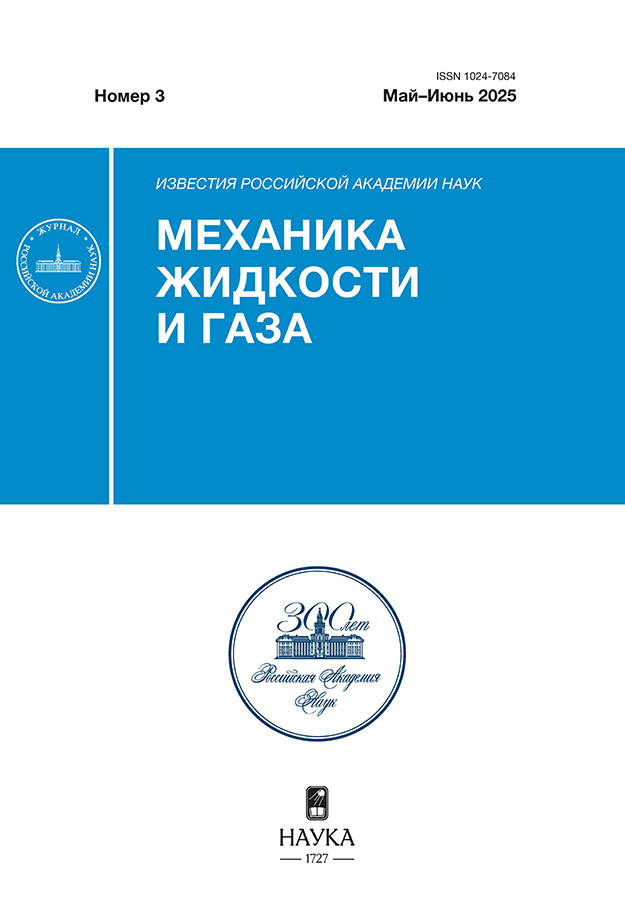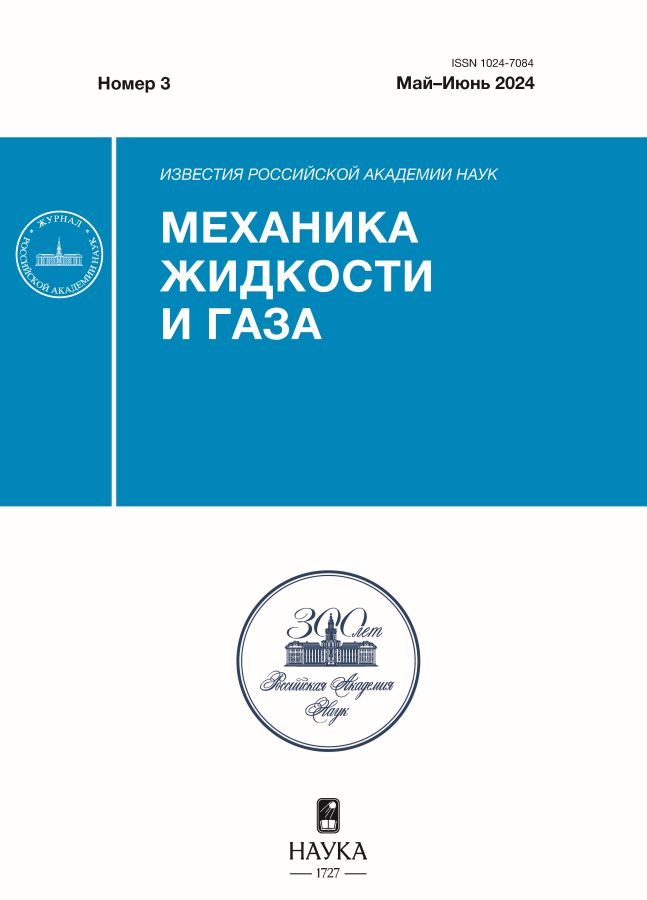Пространственная континуальная модель формирования просвета в кластере клеток, погруженном во внеклеточный матрикс: роль механических факторов
- Авторы: Логвенков С.А.1,2
-
Учреждения:
- Национальный исследовательский университет «Высшая школа экономики»
- МГУ им. М. В. Ломоносова
- Выпуск: № 3 (2024)
- Страницы: 3-19
- Раздел: Статьи
- URL: https://medjrf.com/1024-7084/article/view/682508
- DOI: https://doi.org/10.31857/S1024708424030012
- EDN: https://elibrary.ru/PGHAUN
- ID: 682508
Цитировать
Полный текст
Аннотация
Исследуется степень участия механизмов, таких как активные взаимодействия клеток между собой и с внеклеточным матриксом, повышенное гидростатическое давление в межклеточной жидкости и ферментативная активность клеток, приводящая к разрушению внеклеточного матрикса, в процессе формирования полостей в кластерах клеток, образующихся во время кластерного васкулогенеза. В рамках разработанной ранее континуальной многофазной модели среды, образованной двумя активно взаимодействующими твердыми фазами и жидкостью, решена задача об эволюции одиночного кластера клеток, погруженного в деформируемый внеклеточный матрикс и проведено исследование роли различных клеточных механизмов, обсуждаемых при формировании полых структур. Расчеты показали, что доминирование активных взаимодействий типа клетка–матрикс над межклеточными взаимодействиями приводит к смещению клеток в сторону внешней границы кластера и созданию условий для образования полости внутри него. Ферментативная активность клеток способствует освобождению свободного пространства для уплотнения кластера вследствие активных межклеточных взаимодействий и замедлению формирования возрастающего профиля концентрации клеточной фазы. Увеличение давления жидкости в занятой клетками области приводит к ускорению перераспределения концентраций клеточной фазы и матрикса. Давление жидкости способствует накоплению клеточной фазы около границы кластера и росту концентрации матрикса в центральной его части. И лишь совместное участие всех рассмотренных механизмов приводит к формированию структуры, в которой слой, образованный клеточной фазой, окружает заполненную жидкостью полость, при этом концентрация матрикса в полости демонстрирует тенденцию к его полному исчезновению.
Ключевые слова
Полный текст
Об авторах
С. А. Логвенков
Национальный исследовательский университет «Высшая школа экономики»; МГУ им. М. В. Ломоносова
Автор, ответственный за переписку.
Email: logv@bk.ru
Научно-исследовательский институт механики
Россия, Москва; МоскваСписок литературы
- Sutherland A., Keller R., Lesko A. Convergent extension in mammalian morphogenesis // Sem. Cell Dev. Biol. 2020. V. 100. P. 199–211.
- Janiszewska M., Primi M.C., Izard T. Cell adhesion in cancer: Beyond the migration of single cells // J. Biol. Chem. 2020. V. 295. № 8. P. 2495–2505.
- Tracqui P. Biophysical models of tumour growth // Rep. Progr. Phys. 2009. V. 72. № 5. P. 056701.
- Mammoto T., Ingber D.E. Mechanical control of tissue and organ development // Development. 2010. V. 137. № 9. P. 1407–1420.
- Friedl P., Gilmour D. Collective cell migration in morphogenesis, regeneration and cancer// Nat. Rev. Mol. Cell Biol. 2009. V. 10. P. 445–457.
- Blatchley M.R., Hall F., Wang S., Pruitt H.C., Gerecht S. Hypoxia and matrix viscoelasticity sequentially regulate endothelial progenitor cluster-based vasculogenesis // Sci Adv. 2019. V. 5. № 3. P. eaau7518.
- Wang S., Sekiguchi R., Daley W.P., Yamada K.M. Patterned cell and matrix dynamics in branching morphogenesis // J. Cell Biol. 2017. V. 216. № 3. P. 559–570.
- Davis G.E., Senger D.R. Endothelial extracellular matrix: biosynthesis, remodeling, and functions during vascular morphogenesis and neovessel stabilization // Circulat. Res. 2005. V. 97. № 11. P. 1093–1107.
- Poole T.J., Coffin D. Vasculogenesis and angiogenesis: Two distinct morphogenetic mechanisms establish embryonic vascular pattern // J. Exp. Zool. 1989. V. 251. № 2. P. 224–231
- Serini G., Ambrosi D., Giraudo E., Gamba A., Preziosi L., Bussolino F. Modeling the early stages of vascular network assembly // EMBO J. 2003. V. 22. № 8. P. 1771–1779.
- Ambrosi D., Gamba A., Serini G. Cell Directional and chemotaxis in vascular morphogenesis // Bull. Math. Biol. 2004. V. 66. № 6. P. 1851–1873.
- Ambrosi D., Bussolino F., Preziosi, L. A review of vasculogenesis models // J. Theor. Med. 2005. V. 6. № 1. P. 1–19.
- Kowalczyk R., Gamba A., Preziosi L. On the stability of homogeneous solutions to some aggregation models // Discrete Contin. Dyn. Syst. B. 2004. V. 4. № 1. P. 203–220.
- Scianna M., Bell C.G., Preziosi L. A review of mathematical models for the formation of vascular networks // J. Theor. Biol. 2013. V. 333. P. 174–209.
- Manoussaki D. A mechanochemical model of angiogenesis and vasculogenesis // Math. Model. Num. Anal. 2003. V. 37. № 4. P. 581–599.
- Namy P., Ohayon J., Traqui P. Critical conditions for pattern formation and in vitro tubulogenesis driven by cellular traction fields // J. Theor. Biol. 2004. V. 227. P. 103–120.
- Murray J.D., Oster G.F. Cell traction models for generating pattern and form in morphogenesis // J. Math. Biol. 1984. V. 19. P. 265–279.
- Murray J.D., Maini P.K., Tranquillo R.T. Mechanochemical models for generating biological pattern and form in development // Phys. Rep. 1988. V. 171, № 2. P. 59–84.
- Tosin A., Ambrosi D., Preziosi, L. Mechanics and Chemotaxis in the Morphogenesis of Vascular Networks // Bull. Math. Biol. 2006. V. 68. P. 1819–1836.
- Camacho-Gomez D., Garcia-Aznar J.M., Gomez-Benito M.J. A 3D multi-agent-based model for lumen morphogenesis: the role of the biophysical properties of the extracellular matrix // Eng. Comput. 2022. V. 38. P. 4135–4149.
- Fuji K., Tanida S., Sano M., Nonomura M., Riveline D., Honda H., Hiraiwa T. Computational approaches for simulating luminogenesis // Sem. Cell Dev. Biol. 2022. V. 131. P. 173–185.
- Villa C., Gerisch A., Chaplain M.A.J. A novel nonlocal partial differential equation model of endothelial progenitor cell cluster formation during the early stages of vasculogenesis // J Theor Biol. 2022. V. 534. P. 110963.
- Логвенков С.А. Математическая модель биологической среды с учетом активных взаимодействий и взаимных перемещений составляющих ее клеток // Изв. РАН. МЖГ. 2018. № 5. С. 3–16.
- Логвенков С.А., Юдина Е.Н. Исследование развития полости в клеточном сфероиде в зависимости от механизмов активных межклеточных взаимодействий // Изв. РАН. МЖГ. 2021. № 2. С. 3–14.
- Логвенков С.А., Штейн А.А. Континуальное моделирование биологической среды, составленной активно взаимодействующими клетками двух разных типов // Изв. РАН. МЖГ. 2020. № 6. С. 3–16.
- Lecuit T., Lenne P.F., Munro E. Force generation, transmission, and integration during cell and tissue morphogenesis // Ann. Rev. Cell Dev. Biol. 2011. V. 27. P. 157–184.
- Логвенков С.А. Математическое моделирование влияния клеточной подвижности и межклеточных активных взаимодействий на сортировку двух типов клеток в культурах биологических тканей // Изв. РАН. МЖГ. 2023. № 2. С. 9–19.
- Stein A.A., Logvenkov S.A., Volodyaev I.V. Continuum modeling of mechano-dependent reactions in tissues composed of mechanically active cells // BioSystems. 2018. V. 173. P. 225–234.
- Белоусов Л.В., Логвенков С.А., Штейн А.А. Математическая модель активной биологической сплошной среды с учетом деформаций и переупаковки клеток // Изв. РАН. МЖГ. 2015. № 1. С. 3–14.
- Логвенков С.А., Штейн А.А. Континуальное моделирование сортировки клеток в плоском слое с учетом возможного расхождения границ областей, занятых клетками двух разных типов // Изв. РАН. МЖГ. 2022. № 3. С. 1–14.
- Forgacs G., Foty R.A., Shafrir Y., Steinberg M.S. Viscoelastic properties of living embryonic tissues: a quantitative study // Biophys. J. 1998. V. 74. P. 2227–2234.
- Jakab K, Damon B, Marga F, Doaga O, Mironov V, Kosztin I, Markwald R, Forgacs G. Relating cell and tissue mechanics: implications and applications // Dev. Dyn. 2008. V. 237. № 9. P. 2438–2449.
- Stirbat T.V., Mgharbel A., Bodennec S. et al. Fine tuning of tissues viscosity and surface tension through contractility suggests a new role for a-catenin // PLoS One. 2013. V. 8. № 2. e52554.
- Gordon R., Goel N.S., Steinberg M.S., Wiseman L.L. Arheological mechanism sufficient to explain the kinetics of cell sorting // J. Theor. Biol. 1972. V. 37. P. 43–73.
- Lubkin S.R., Jackson T. Multiphase Mechanics of Capsule Formation in Tumors // J. Biomech. Eng. 2002. V. 124. P. 237–243.
- Lemon G., King J.R. Multiphase modelling of cell behaviour on artificial scaffolds: effects of nutrient depletion and spatially nonuniform porosity // Math.Med.Biol. 2007. V. 24. № 1. P. 57–83.
- Swabb E.A., Wei J., Cullino P.M. Diffusion and Convection in Normal and Neoplastic Tissues // Cancer Res. 1974. V. 34. № 10. P. 2814–2822.
- Boucher Y., Brekken C., Netti P.A., Baxter L.T., Jain R.K. Intratumoral infusion of fluid: estimation of hydraulic conductivity and implications for the delivery of therapeutic agents // British J. Cancer. 1998. V. 78. № 11. P. 1442–1448.
- Логвенков С.А. Континуальное моделирование сортировки двух типов клеток в клеточном сфероиде с учетом подвижности границ областей, занятых клетками разных типов // Изв. РАН. МЖГ. 2022. № 6. С. 101–115.
- Davis G.E., Senger D.R. Endothelial extracellular matrix: biosynthesis, remodeling, and functions during vascular morphogenesis and neovessel stabilization // Circ. Res. 2005. V. 97. № 11. P. 1093–1107.
- Datta A., Bryant D.M., Mostov K.E. Molecular regulation of lumen morphogenesis // Curr. Biol. 2011. V. 21. № 3. P. R126–R136.
- Navis A., Bagnat M. Developing pressures: fluid forces driving morphogenesis // Curr. Opin. Genet. Dev. 2015. V. 32. P. 24–30.
- Chan C.J., Hiiragi T. Integration of luminal pressure and signalling in tissue self-organization // Dev. 2020. V. 147. № 5. P. dev181297.
- Painter K.J., Armstrong N.J., Sherratt J.A. The impact of adhesion on cellular invasion processes in cancer and development // J. Theor. Biol. 2010. V. 264. № 3. P. 1057–1067.
- Mansurov A.N., Stein A.A., Beloussov L.V. A simple model for estimating the active reactions of embryonic tissues to a deforming mechanical force // Biomech. Model. Mechanobiol. 2012. V. 11. P. 1123–1136.
Дополнительные файлы
















